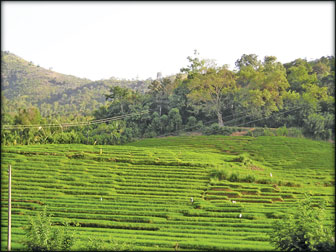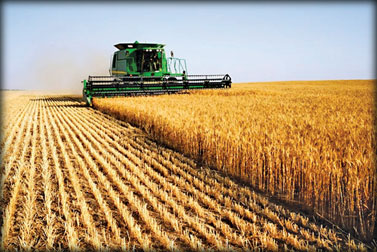|
 Modern farming vs traditional farming: Modern farming vs traditional farming:
Should we go back?
By Thulasi MUTTULINGAM
Human history is filled with stories of technological and industrial
advances and their various repercussions. We are daily reminded of these
advances when we watch or read the news these days. Not many people can
imagine a life without electricity, but the cost of effective, efficient
and cheap electricity could be explosions at nuclear reactors such as
the one in Japan. The current nuclear crisis has eclipsed another
problem that has been debated for years now; that of modern farming vs
organic farming.
Modern farming methods evolved for a reason - to adequately provide
food for the vastly overpopulated world. Pessimistic predictions by
economists and other experts in the 1950s, that the world was about to
experience large-scale famine, was averted, mostly due to the efforts of
one man, Norman Borlaug, an American agricultural scientist who
researched and came up with high yielding varieties of grain, to
increase their production value.
Unfortunately, while famine on the scale that was once feared as a
global catastrophe was averted, with many countries not only producing
enough to meet their own needs, but surpluses to export as well, modern
farming technology has brought with it its own problems.
Many countries are now trying to go back to their time-tested
traditional methods of farming. In Sri Lanka, the Future in Our Hands
Development Fund (FIOH), a local NGO established in 1986, has been
investigating traditional farming methods in depth and is trying to
reintroduce it to farmers, to overcome the various problems caused by
modern agriculture.
 |
|
Dr. P. B. Dharmasena |
Dr. P.B. Dharmasena, an agricultural consultant for the FIOH, has
published two books on his research work for them: Traditional and
Efficient Ways of Paddy Cultivation (Sinhala) and Assessment of
Traditional Rice Farming - A case study from Moneragala district of Sri
Lanka (English).
Green Revolution
What exactly are the problems associated with modern agriculture?
According to Dr. Dharmasena, modern agriculture came about with the
Green Revolution which took place soon after World War II, because of
the food crisis. Many countries came out with a food program that
involved four components:
* High yielding varieties of grains to increase food production
* Mechanisation - because more land was cultivated and small ploughs
with buffaloes weren't enough.
* Pesticides and weedicides - the new plants were not resistant to
pests and diseases, therefore agrochemicals were introduced to help them
out.
* Inorganic fertiliser - the soil needed to be highly productive and
organic fertiliser need time to decompose. Plants could access the
nutrients from inorganic fertiliser faster.
 |
|
Dr. P.B. Dharmasena's
publications |
Unfortunately, the scientists who introduced them omitted to look at
the consequences of such farming. It was a case of coriander vs aspirin.
The coriander might take some time to prepare and obtain results for
headaches, but unlike aspirin, there won't be any side effects, Dr.
Dharmasena said.
So what were the consequences?
"First, the mechanisation. Large ploughs which could plough up to 12
inches were introduced. The earlier ploughs tilled the soil only up to
four to six inches. There is a hardpan underneath the soil which was
left undisturbed. The water and nutrients were thus at an optimum level.
"The hardpan was formed by generations of agriculture. The buffaloes
feet can penetrate up to six inches of soil and when ploughed, it formed
the hardpan underneath. The big plough however breaks the soil up to one
foot, breaking up the hardpan in the process. The water is percolating
inside as also are the nutrients. In the earlier days of traditional
farming, water was filled two to three inches above the soil layer to
control weeds.
"Now, when the water percolates down to 12 inches below soil level,
the rice plants cannot extend that far down, but weeds can. The weeds
are winning the competition so the solution is to apply weedicides -
more agrochemicals," he said.
Inorganic fertiliser
Nutrients have also percolated deep down with the water so inorganic
fertilisers are added. But inorganic fertiliser dissolve easily in
water, and so percolate down because of the lack of a hardpan. For
example, studies show that only 30 percent of Nitrogen fertiliser are
used by plants; the rest percolates beyond their reach.
Crop plants also need micronutrients in addition to Nitrogen,
Phosphorous and Potassium. Inorganic fertiliser do not have these
micronutrients although traditional organic fertiliser such as compost
do. The crop therefore suffers from a variety of micronutrient
deficiencies such as whitening, yellowing and retardation of growth.
Most importantly though, they are susceptible to pest and disease
attack. Again a solution is sought through agrochemicals - pesticides,
fungicides etc.
 |
|
Traditional
agricultural methods of Sri Lanka |
The microbes in the soil, responsible for breaking down refuse and
making it ready as food for plants, have been wiped out by the
chemicals. We say, "The soil is dead now."
Modern rice farming is facing a chain of problems, one after the
other, which keeps going round in a vicious circle, Dr. Dharmasena said.
Modern farming methods were introduced for a reason - to provide food
for the entire world. Will going back to traditional farming, with
traditional varieties of rice, which have typically lower yields,
address the food security concerns of the world?
"Forget the world. As far as Sri Lanka is concerned, we can produce
enough to feed our nation adequately. We can increase our produce of
traditional varieties through adequate water management and more
cropping seasons. We also have 0.97 million hectares of arable land (not
forested), which is idling. So we can also farm more land if necessary,"
he said.
According to Dr. Dharmasena, "We have several objectives for
promoting traditional farming.
"The first is money. Farmers have been misled when they were told
that planting the new, high yielding crops would lead to more revenue
for them.
"Due to agrochemicals, fields that yielded 50 bushels of rice might
give 100 bushels of rice, but the cost of the agrochemicals themselves
would match the revenue earned by the extra 50 bushels."
Second concern
 |
|
Modern agricultural
implements |
"Our second concern is nutrients. We might be producing more food but
this food does not have the nutrients required for us.
"For example, all the traditional varieties of rice contain
glutamine, which helps to develop antibodies (for disease resistance) in
our bodies. None of the new, improved varieties of rice contain
glutamine.
"Traditional varieties also had other specific uses. For example,
Suwandel and Pachchaiperumal are good for diabetes patients.
"The new varieties of rice are low in nutrients. People will become
weak by consuming them."
"Thirdly, we want to promote biodiversity. Fields contain pests, the
predators of pests as well as neutral fauna which don't destroy
anything. Pesticides indiscriminately kill all these. When you don't use
inorganic chemicals, we can increase the biodiversity of plants, animals
and insects."
"In nature, predator populations are double that of pests. That is
the blessing of nature and we can depend on it to take care of pests."
|

